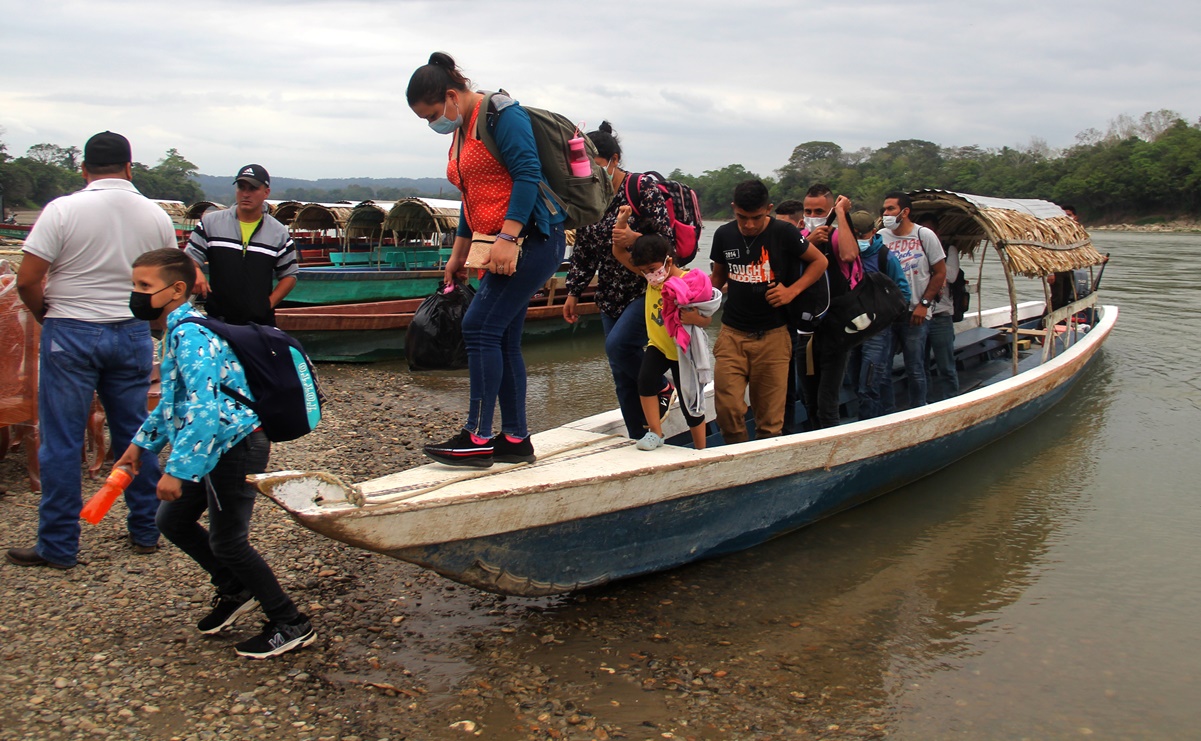
Frontera Corozal. – In the midst of the howling of the monkeys and the song of the birds, dozens Central American Migrants cross irregularly to daily Mexican Territory on board boats by the Usumacinta river, which serves as a political divide between Mexico and Guatemala, a place where until the weekend no sanitary filter nor security.
While the federal government the presence of elements of the National Institute of Migration (INM) and the National Guard (GN) In Tapachula and the banks of the Suchiate River, migrants enter the national territory without anyone stopping them, more than 560 kilometers to the northeast, among the Lacandon jungle.
On this border, located 165 kilometers from the municipal seat of Palenque and almost two kilometers from the archaeological zone of Yaxchilán, you will sail the Usumacinta River – the largest river in Mexico and the longest in Central America– The arrival of boats laden with young people and women transporting their minor children, mainly from Honduras, Guatemala and The Savior
Also read: Border agents released migrants without a date to be heard, detained in US: NBC News
This route is used by smugglers and migrants traveling alone, due to the zero control of the INM, the National Guard and the Mexican Army.
During a tour last Saturday, it was found that dozens of migrants from the Guatemalan side are arriving in the town known as La Técnica, where they board the boats crossing the river to Frontera Corozal, belonging to the municipality of Ocosingo.

On the Mexican side, traffickers have already hired local taxi drivers to transport people to safe houses. Foreigners traveling alone are stripped of the little money they carry by alleged Guatemalan police officers as payment for not being detained and repatriated to their country of origin.
They have to walk for a maximum of seven days along the side of the road and in parts through the jungle to Palenque, their first destination.
At this border point, between the Montes Azules Biosphere Reserve and the Sierra del Lacandón National Park, until last weekend the government had not deployed any personnel to prevent the passage of undocumented migrants, as was done in Tapachula under the restrictions that began on March 19, valid for 30 days, to withhold the entry of migrants. Nor was the presence of health personnel reinforced to the health protocols imposed by the pandemic from COVID-19
Also read: They arrest 95 migrants from Central America who tried to cross Mexico as tourists
In this area, the risk is not stopped by migration, but by snakes and jaguars.

Foreigners include women who travel with their children and minors.
With free passage
The border points with Guatemala from El Ceibo, in Tenosique, Tabasco, as well Corozal border and Benemérito de las Américas, in Chiapas, are the routes used by smugglers and migrants. Until last Saturday, they were unsupervised by a federal company; only the checkpoints of the local authorities are observed.
Between the howls of monkeys swinging in giant trees and the singing of various birds, such as the quetzal, parrots, cuchas and parrots of different varieties, small caravans of migrants, who have no money to pay for transport, walk past the Lacandon jungle, Jaguar Territory.
Groups of foreigners are observed day and night along the highway between Frontera Corozal and Palenque.
Antonio, Daniel and Jairo are part of a group of 12 young Hondurans who have been hiking for three days. They ask for some water and food to get ahead. They estimate that they will reach Palenque in four days.
Also read: 53 Central American migrants rescued in Veracruz
They look tired. They say they try to walk a bit at night but they are afraid of being attacked by snakes or a jaguar as precautions have been taken as they are a feline area.
The indigenous people of Chol and Lacandon who live in the region point out that they observe the passage of migrants on a daily basis, many of them asking for shoes, food and water.
After running 165 kilometers, men and women pause in the municipal seat of Palenque. Some of them stay in the Jtatic Samuel Ruiz hostel. Last Friday, half a thousand migrants were observed near the site.

By Tabasco
The income for Tenosique, Tabasco, it is no less harsh. From that side, foreigners were observed to enter the national territory through blind spots on the border of El Naranjo, Guatemala-El Ceibo, Mexico, walking 40 miles (64 kilometers) along the railway line and marshy meadows, at temperatures above 36 degrees.
After a walk of four to five days, the migrants make a stopover in the inn La 72, located in Tenosique, and will continue their journey to Palenque, where they will continue their journey to the United States border, along the route that crosses the states of Veracruz and Tamaulipas. The hardest is yet to come.